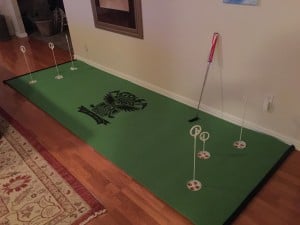A single 3″ putt carries the same weight as a 300 yard drive.
Today, I have a video teaching you a game Rich and I created in tribute to Caddyshack. You can watch the video later in this article, and the head to the course and play it to develop your ‘clutch’ putting. But first, let’s talk about that short putt versus a long drive…
Doesn’t sound fair when you consider it in terms of distance covered. However, putting is much more difficult than driving in my opinion. So… to lower that handicap, you need to devote time to putting.
If you are like me, then your putting ebbs and flows like the tide. When things go off the deep end, I revisit my practice habits. Usually, a quick return to the basics cures me and puts my putts on the right path again.
Here’s my practice formula for becoming a Clutch putter:
- Mechanics are practiced on my perfectly flat indoor putting mat.
- Speed and feel are practiced at my local Country Club practice green.
- To develop confidence under pressure, I play a variety of Challenges by myself or against other golfers.
Mechanics
If you are working on purely mechanics at your local course putting green, you are wasting time in my opinion. Mechanics are for your living room carpet or a controlled environment.
Mechanics shouldn’t be judged on a putting surface that is not completely flat. For example, you might strike a perfectly pure putt on the practice green only to find it miss the intended target.
You mind takes over and on your next putt, you may attempt to steer the putt.
I think this is where a lot of amateur golfers go wrong with their putting practice regimens.
I find it easier and more satisfying to work on mechanics in my living room. Recently, I purchased a BirdieBall indoor putting green and use it off an on throughout the course of a day.
Obviously, you have to make due with the resources at hand and practicing at home may not be an option. In that case, try to work on mechanics on VERY short putts and ensure you have a level and completely flat surface.
Another issue with practicing at the golf course are green conditions. There are two conditions that can really impact the ball… grain and the hole itself. First, grain obviously grows in different patterns and will affect the ball. The second item is the hole itself – it begins to become a volcano near the end of the day. As people step around the hole to pick up their ball, the cup lip begins to rise.
When working on mechanics, it’s my personal preference to take all the other factors out of play. I want to be absolutely sure that I am judging my stroke, alignment, and grip without any other factors that can affect the ball.
Speed and Feel
The second thing to work on to become a clutch putter is speed.
Speed kills.
Literally, watch a good golfer and a bad golfer and where their putts end up.
The bad golfer can usually find the right line, but his ball ends up way short or way past the hole. In this case, speed kills his chances of scoring well.
When I hit the practice green at my Country Club, I focus on speed and variety. Rarely, I practice the same putts more than twice. This builds up my feel quickly. If I’m stroking putt after putt to the same hole I’m not really learning anything except for that particular spot on the green… as we know, golf is anything but consistent in terms of where we play our putts from.
Developing Confidence Under Pressure
Staying with our random practice concept, we now throw in competition to the mix. This is to replicate the pressure we feel on the golf course playing in a match against our buddies.
By playing a game against yourself or your friends, you can build up confidence that is a valuable commodity on the course.
In fact, Rich and I filmed a game you can play at your local course practice green. Watch the video below as I destroy Rich during the filming of this game.
And that’s really all there is to it. I try to keep it simple and short… my practices rarely last more than 15 to 20 minutes at home or on the practice green.


